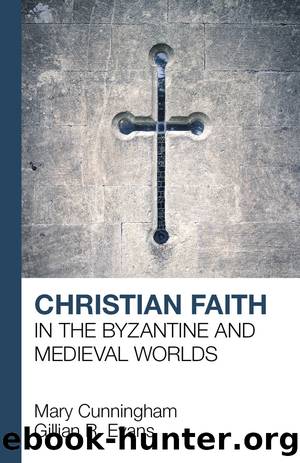Christian Faith in the Byzantine and Medieval Worlds by Cunningham Mary;Evans G. R.;

Author:Cunningham, Mary;Evans, G. R.;
Language: eng
Format: epub
Publisher: Lion Hudson
CHRONOLOGY
â¡â â 306â37 Constantine I, âthe Greatâ (sole ruler from 324).
â¡â â 312 Constantineâs vision and subsequent victory at the Milvian Bridge, Italy.
â¡â â 325 Council of Nicea, first ecumenical (universal) Church council. This council formally rejected the teachings of Arius and stated that the Son is homoousios (of one essence) with the Father.
â¡â â 330 Inauguration of Constantinople as the âNew Romeâ.
â¡â â 337 Baptism and death of Constantine I.
â¡â â 381 Second ecumenical council: the Council of Constantinople. This council again rejected Arianism as a heresy and affirmed the divinity of the Holy Spirit. It also established Constantinople as the second most important episcopal see after Rome.
â¡â â 431 Third ecumenical council: the Council of Ephesus, at which the title Theotokos (âGod-bearerâ) for the Virgin Mary was approved.
â¡â â 450â51 Fourth ecumenical council: the Council of Chalcedon. This council affirmed âtwo naturesâ in Christ, a doctrine which some bishops, especially in the Eastern patriarchates, felt that they could not accept. Major schisms eventually developed as a result of the definitions formulated at the Council of Chalcedon.
â¡â â 527â65 Reign of the Byzantine emperor Justinian.
â¡â â 537 Dedication of the new Church of the Holy Wisdom (Hagia Sophia) in Constantinople.
â¡â â 553 Fifth ecumenical council held in Constantinople. Attempts were made to reconcile the Monophysite Churches.
â¡â â 614 The Persians occupied Syria, Palestine and Egypt (formerly Roman territories). The relic of the true cross was taken to Ctesiphon, the Persian capital.
â¡â â 622 Muhammad left Mecca for Medina. (Muslims call this journey the Hijra.)
â¡â â 622â27 Campaigns of the Byzantine emperor Herakleios against the Persians.
â¡â â 626 Failure of the combined siege of Constantinople by the Persians and the Avars. The Byzantines viewed this victory as divinely ordained, especially due to the help of Mary, the Mother of God.
â¡â â 626â28 Byzantine defeat of the Persians.
â¡â â 630 The relic of the true cross was restored to Jerusalem amid great rejoicing.
â¡â â 634â46 The Muslims conquered Syria, Palestine, Mesopotamia and Egypt.
â¡â â 638 The Ekthesis, a statement published by the emperor Herakleios and his ecumenical patriarch, Sergios, which attempted to reconcile Monophysites and Chalcedonians.
â¡â â 655 Pope Martin I and the Byzantine theologian Maximos the Confessor were found guilty of treason for opposing the imperial âMonotheliteâ (âone willâ in Christ) doctrine. Both were exiled and died shortly afterwards.
â¡â â 680â81 Sixth ecumenical council held at Constantinople. The doctrine of Monothelitism was officially rejected.
â¡â â 717â18 The Muslims besieged Constantinople. Leo III, formerly a general, seized power.
â¡â â 730 The patriarch Germanos resigned. This was due to the introduction of the imperial policy against holy icons, called âIconoclasmâ.
â¡â â 741â75 Reign of the iconoclast emperor Constantine V. More active persecution of the defenders of icons (called iconophiles) began. Monks and monasteries especially were targeted.
â¡â â 754 The iconoclast Council of Hiereia, at which the policy against images was formally stated.
â¡â â 787 The seventh ecumenical council, held at Nicea, ended the iconoclast policy. The use and veneration of icons in Orthodox Christian worship was affirmed.
â¡â â 800 Papal coronation of the Frankish king Charlemagne, as Roman emperor in the West, took place in St Peterâs Basilica, Rome. The Byzantines refused to recognize his claim.
â¡â â 811â13 Bulgarian victories over the Byzantines in the Balkans. The emperor Nikephoros was defeated and killed in battle.
â¡â â 815 Reintroduction of iconoclast policy under the emperor Leo V.
Download
This site does not store any files on its server. We only index and link to content provided by other sites. Please contact the content providers to delete copyright contents if any and email us, we'll remove relevant links or contents immediately.
The Lost Art of Listening by Michael P. Nichols(7159)
Why I Am Not A Calvinist by Dr. Peter S. Ruckman(4045)
The Rosicrucians by Christopher McIntosh(3371)
Wicca: a guide for the solitary practitioner by Scott Cunningham(3040)
Signature in the Cell: DNA and the Evidence for Intelligent Design by Stephen C. Meyer(2875)
Real Sex by Lauren F. Winner(2861)
The Holy Spirit by Billy Graham(2775)
To Light a Sacred Flame by Silver RavenWolf(2674)
The End of Faith by Sam Harris(2629)
The Gnostic Gospels by Pagels Elaine(2393)
Waking Up by Sam Harris(2329)
Nine Parts of Desire by Geraldine Brooks(2278)
Jesus by Paul Johnson(2224)
Devil, The by Almond Philip C(2202)
Heavens on Earth by Michael Shermer(2185)
The God delusion by Richard Dawkins(2182)
Kundalini by Gopi Krishna(2089)
Chosen by God by R. C. Sproul(2053)
The Nature of Consciousness by Rupert Spira(1975)
